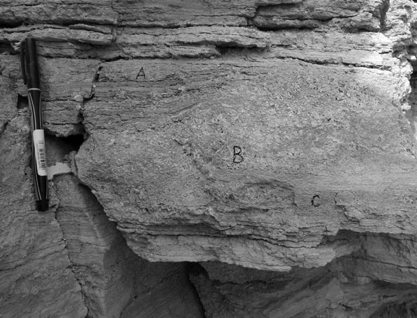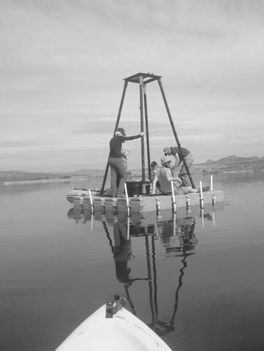Reports: UR854934-UR8: Reservoir Heterogeneity and Facies Characterization of Rift Basin Microbial Carbonate Lakes: Insights from the Miocene Horse Spring Formation and the Modern Lower Pahranagat Lake
Thomas A. Hickson, PhD, University of St. Thomas
Kevin M. Theissen, PhD, University of St. Thomas
We accomplished many of the goals that we set forth for the first year of this project and completed other, unplanned objectives that will lead to greater efficiencies in the following years.
Development of a lacustrine microbialite database. We devised a field and lab sampling plan that meshes with a relational database. The organization of this database is hierarchical, helping shed light on the multi-scale nature of microbialite textures and sedimentary structures. In the field, researchers seek out macrostructures, isolated microbial build-ups that are comprised by a range of one or more mesostructures (figure 1). Macrostructures may range from 0.1 to greater than 2 m in scale, whereas mesostructures are at the hand sample scale. In the field, we describe and georeference macro- and mesostructures, then collect samples of the mesostructures for microstructural, textural, and geochemical analysis. The relational database is organized on this hierarchy such that field observations are entered for each macro- and mesostructure. This database links to ArcGIS and can be queried to investigate linkages and patterns within the microbialites that we have sampled. We have shared this database with Julie Bartley and the microbialites team at Gustavus Adolphus College.
Figure 1. Example of a macrostructure comprised of three mesostructures, labeled A-C.
Fieldwork, March 2015 and January 2016. In the spring of 2015 two undergraduate students accompanied grant personnel to the White Basin (Nevada) to sample microbialite macrostructures. They traced individual lacustrine microbialite-bearing beds from the basin toward the basin margin (based on our pre-existing basin reconstruction). In January of 2016, as part of our department's field course, a larger group of undergraduate students accompanied grant personnel to outcrops to the same area and sampled a much wider range of microbialite features.
Pahranagat coring trip, March 2016. We constructed a new, portable coring platform and headframe (figure 2) during the summer and fall of 2015 that allows us to extract deeper lake cores (this platform was funded by geology department budget, not from this grant). Three undergraduate researchers accompanied the PIs to the Lower Pahranagat Lake and we collected a 12 meter core from the main lake basin. This is 3 times longer than our prior coring efforts. Wind conditions prevented us from completing a second core and an attempt to take a longer core. We have scheduled a second coring trip in October, 2016, to attempt to get these new cores.
Figure 2. Portable coring platform and headframe, on Lower Pahranagat Lake.
2015-16 academic year lab research. Two students prepped samples for thin sectioning and cathodoluminescence, as well as collaborating on the design of the relational database. Sample chips were sent out for thin section prep in mid spring so that we would have samples for the summer. We also sub-sampled the upper 4 meters of Lower Pahranagat lake sediments and analyzed them using ICP-MS at Gustavus Adolphus College.
Summer 2016 student research. Five students worked on this project during this timeframe. All five students participated in two microbialite workshops led by the PIs and Dr. Julie Bartley (Gustavus Adolphus College).
Horse Spring microbialites: The main goal(s) of the summer were to train students on petrographic analysis, cathodoluminescence imaging, and sampling for trace element analyses. Students chose two or three macrostructures from which we already had thin sections and worked to describe and interpret these features. One student also worked on 3D imaging, petrographic analysis, and geochemical characterization of Holocene and Miocene domal stromatolites. These students are currently compiling their results for presentation at a GSA meeting in the spring or next fall.
Lower Pahranagat cores. One student focused her efforts on creating a detailed lithological log of the new core and sub-sampling it at high resolution, then running samples on a C/N Analyzer for C, N, and CaCO3 content. The other student worked with LacCore personnel to develop an improved method for epoxy impregnation of soft sediment samples for petrographic analysis. She was very successful in creating thin sections of Pahranagat core facies. Both of these students have sampled organic rich portions of the core for 14C dating, completed smear slide and macrofossil inspections throughout the core, and started downcore sample prep for stable isotopic analysis which will continue this fall.
The research completed to date has had the following major impacts:
-The PI (Hickson), in collaboration with undergraduate students and scientific collaborators outside of this grant, has learned how to create and manage a complex, hierarchical relational database that allows researchers to explore the multi-scale characteristics of lacustrine microbialites. We hope to migrate this database to an SQL server with a web-based interface to allow broader access to these data.
-We have developed a collaborative research relationship with the microbialites research group at Gustavus Adolphus College under Julie Bartley's supervision. This expands the reach of this PRF and that of Dr. Bartley both temporally and spatially. In addition to the Miocene Horse Spring Formation and the modern Lower Pahranagat Lake, we will be able to make comparisons with microbialites from Paleo-Proterozoic, Paleozoic, and Eocene units that are the focus of the Gustavus group.
-We have mastered a relatively simple approach to making thin sections from soft sediment cores that we can use to compare modern analogues to our ancient micro-textures.
-The research has directly impacted the learning of a sizeable group of undergraduate geoscience students. Six were directly involved as paid researchers on the project and they have developed considerable skill with field data collection, sample preparation, analysis, and interpretation. At least eight more were involved in field data collection as part of a field course.
-The project helped motivate us to construct a portable coring platform that will be used by UST faculty and students for many years. We have also made this platform accessible to LacCore and other local institutions upon request and scheduling.
-Several students will be presenting their research at a poster session on the UST campus and will likely present at a regional or national conference within the next year.













